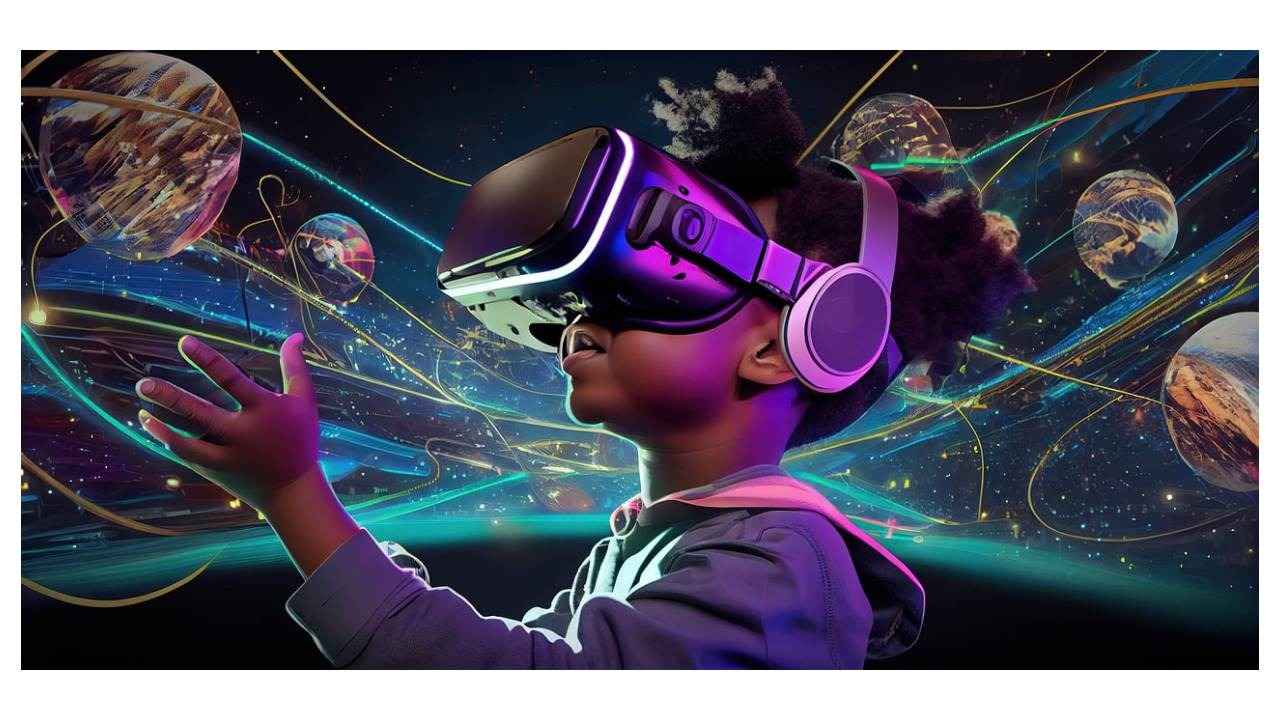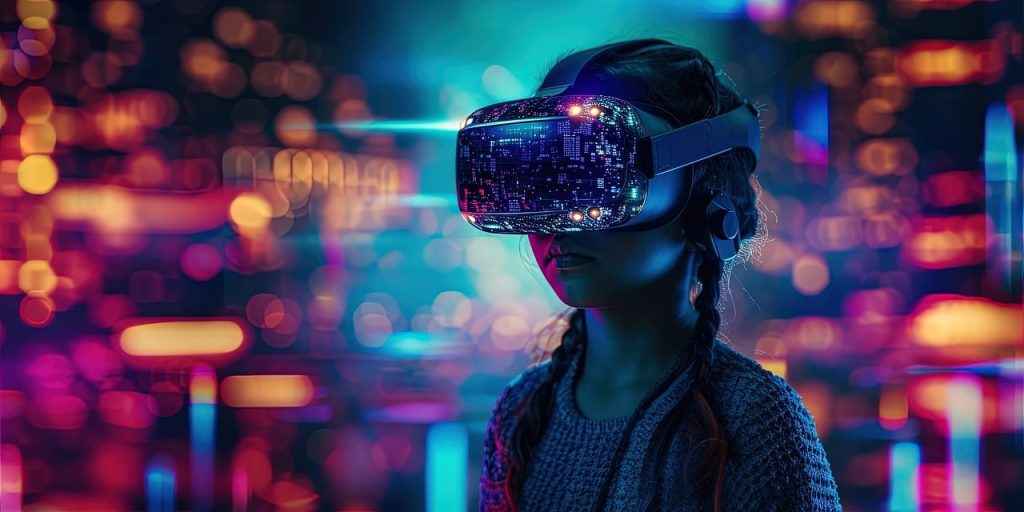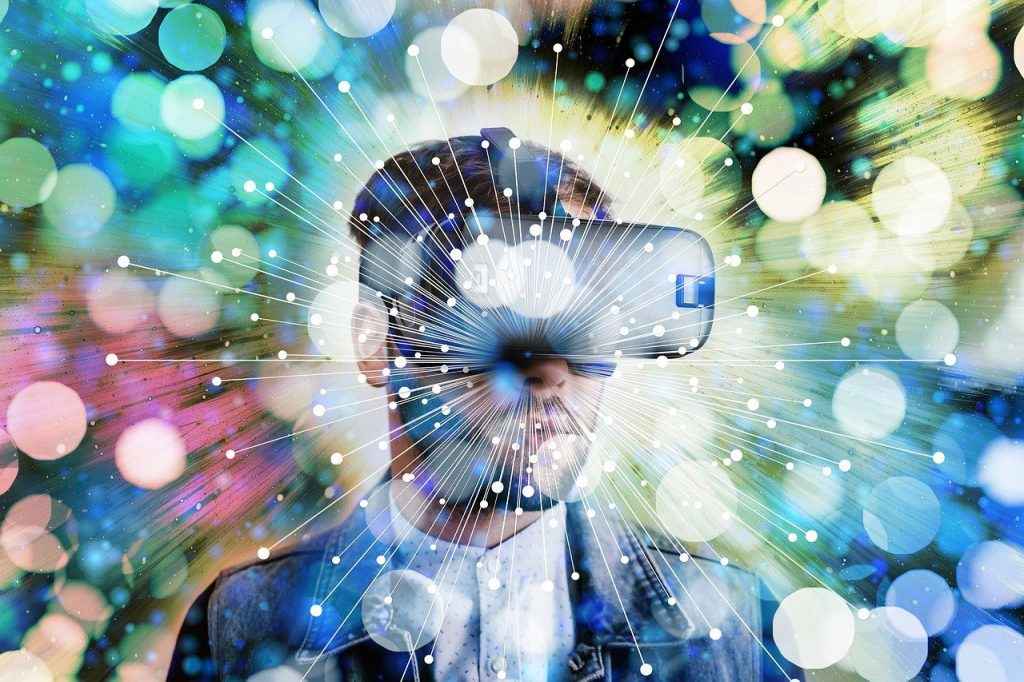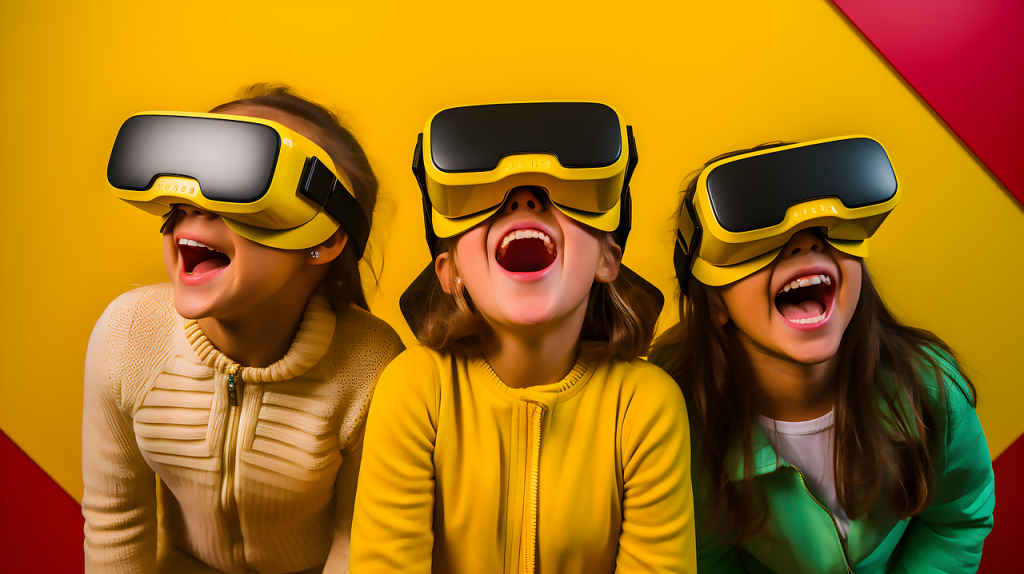What is the Metaverse? Applications, Importance, and How It Works

The Metaverse, often depicted as a sci-fi concept, is now a tangible reality, blending our physical existence with digital augmentation. This chapter serves as your foundational guide, providing insights into what the Metaverse is, the technologies that power it, and how you can be a part of this dynamic ecosystem.
 Survey
SurveyWhat is metaverse?
The first step into the Metaverse begins with grasping its fundamental concepts. This section delves into what the Metaverse actually is: an expansive, interconnected digital universe that blends aspects of virtual reality (VR), augmented reality (AR), and the internet to create immersive, shared experiences. It’s a realm where the physical and digital worlds converge, enabling users to interact, play, work, and socialise in ways previously confined to the realms of science fiction. Following are the key concepts of the metaverse…
Key concepts of the metaverse
- Virtual and Augmented Realities: The Metaverse is often experienced through VR and AR. VR immerses users in a completely digital environment, while AR overlays digital elements onto the real world. Software tools like Oculus Rift and HTC Vive for VR, and ARKit for iOS, ARCore for Android in the realm of A beginner’s guide to Metaverse Start your adventure in the Metaverse with essential knowledge, from basic concepts to navigation. AR, are fundamental in experiencing these realities.
- Persistent and Synchronous World: Unlike traditional digital experiences, the Metaverse is persistent – it continues to exist and evolve even when you’re not logged in. This living digital universe, where events occur in real-time, is a key feature that software platforms like Second Life and Fortnite creatively utilise.
- Interoperability: A core tenet of the Metaverse is interoperability – the ability to take digital items like avatars or assets from one platform to another. This aspect is still in development, but blockchain technologies and platforms like Ethereum are making strides in this area by enabling crossplatform digital assets.
- User-Generated Content: The Metaverse thrives on user-generated content. Platforms like Roblox and Minecraft allow users to create their own worlds and experiences, showcasing the limitless potential for creativity and innovation in the Metaverse.
- Digital Economy: The Metaverse encompasses a fully functional economy, complete with virtual real estate, goods, and services. Cryptocurrencies and non-fungible tokens (NFTs) play a significant role here, with platforms like Decentraland offering opportunities to buy, sell, and trade within the Metaverse using its native currency, MANA.
- Social Interaction: Social platforms like VRChat and Facebook Horizon offer spaces where users can meet, interact, and build communities. These platforms emphasise the social aspect of the Metaverse, where relationships and networks are formed and maintained.
- Accessibility: Accessibility to the Metaverse is made possible through various devices and software. Beyond high-end VR headsets, smartphones and PCs also offer gateways into this digital world, with apps and browsers designed to access Metaverse platforms. By understanding these core aspects, newcomers to the Metaverse can better grasp its vastness and potential. This knowledge serves as a foundation for exploring the numerous possibilities that this digital frontier has to offer, ensuring a more informed and enjoyable experience for all who venture into it.
Also read: Meta Orion AR glasses make Apple Vision Pro look clunky
Key technologies behind the Metaverse
To fully appreciate the Metaverse, it’s crucial to understand the key technologies that make it a reality. This section breaks down these technologies, explaining how they contribute to creating an immersive and interactive digital world. By highlighting specific software tools and applications, we offer a clearer picture of how these technologies are currently being used and how they might evolve in the future.

- VR and AR: Virtual Reality immerses users in a completely digital environment. Tools like Oculus Quest 2 and Valve Index are popular VR headsets providing high-quality immersive experiences. VR software platforms, such as SteamVR and PlayStation VR, offer a range of applications and games, showcasing the potential of VR in the Metaverse. Augmented Reality overlays digital information onto the real world. ARCore by Google and ARKit by Apple are frameworks that enable developers to create AR experiences on Android and iOS devices, respectively. These technologies are pivotal in making AR accessible to a broader audience through smartphones and tablets.
- Blockchain and Cryptocurrency: This technology underpins the idea of decentralised, secure transactions and ownership in the Metaverse. Ethereum, known for its smart contract functionality, is widely used for creating and trading NFTs, crucial for digital ownership and economy within the Metaverse. Digital currencies, like Bitcoin and Ethereum, are used for transactions within the Metaverse. They enable the purchase of virtual goods, services, and real estate, providing a robust economy. Wallets like MetaMask and Trust Wallet are essential tools for managing these cryptocurrencies.
- 3D Modeling and Simulation: Tools like Blender and Autodesk Maya are used to create 3D assets for the Metaverse. These models are crucial for building virtual environments, characters, and objects. Unity and Unreal Engine are powerful game engines that also serve as simulation platforms for the Metaverse. They offer realistic physics, lighting, and interactive capabilities, vital for creating lifelike virtual experiences.
- Artificial Intelligence (AI): AI plays a significant role in the Metaverse for creating intelligent, responsive environments and characters. TensorFlow and PyTorch are popular AI frameworks that enable developers to integrate machine learning and AI into Metaverse applications.
Also read: Open AI Strawberry o1: 5 ways it’s better than ChatGPT 4o
How to access the Metaverse?
Accessing the Metaverse may seem daunting at first, but with the right tools and knowledge, it becomes an exciting and accessible journey. This section is dedicated to guiding beginners on how to enter and navigate the Metaverse, highlighting various software tools, platforms, and applications necessary for this digital expedition.
- Choosing the Hardware: For a fully immersive experience, VR headsets like Oculus Quest 2, HTC Vive, and Sony PlayStation VR are popular choices. These devices provide high-quality visuals and interactive experiences, essential for VR-based Metaverse platforms. Augmented reality experiences can be accessed through smartphones and tablets using ARCore for Android and ARKit for iOS. For more advanced AR, devices like Microsoft HoloLens and Magic Leap offer a more sophisticated experience. Many Metaverse platforms are accessible via standard PCs and laptops. Ensuring a device with sufficient processing power and graphics capabilities is important, especially for graphically intensive environments.
- Software and Apps: Platforms like SteamVR and Oculus Home serve as gateways to various VR experiences in the Metaverse. They offer a range of applications, games, and social spaces that users can explore. For those who don’t have VR or AR hardware, Metaverse browsers and apps provide a window into this world. Platforms like Mozilla Hubs and AltspaceVR can be accessed through standard web browsers, offering a 3D virtual environment experience without specialised hardware.
Specific Metaverse Platforms:
- Second Life: A longstanding virtual world that can be accessed through its dedicated viewer. It’s known for its extensive customisation options and a robust digital economy.
- Decentraland: Accessible via web browsers, Decentraland is a blockchain-based world where users can explore, interact, and trade virtual properties using the MANA cryptocurrency.
- Roblox: A platform that allows users to create and play games. Accessible on PCs, smartphones, and tablets, Roblox is popular for its user-generated content and ease of use. VRChat: Known for its social interaction capabilities, VRChat can be accessed through VR headsets and desktop computers, offering a platform for users to meet, chat, and explore user-created worlds.

Creating and Customizing Avatars:
Many Metaverse platforms provide built-in tools for avatar creation, allowing users to design their virtual representations. For a more advanced and personalised experience, software like Ready Player Me offers cross-platform avatar creation that can be used in multiple Metaverse environments.
By understanding and utilising these tools and platforms, users can easily access and navigate the Metaverse.
How to make the best use of Metaverse?
Navigating the Metaverse effectively is key to maximising the experience it offers. This section provides insights into the tools and techniques for moving through various virtual environments, interacting with digital objects, and communicating with other users. By highlighting specific software and platforms, this guide aims to make your journey in the Metaverse intuitive and enjoyable.
- Understanding Virtual Environments: Spatial awareness is key. Familiarising yourself with the 3D space of the Metaverse is essential. Tools like Google Earth VR and various VR exploration games can help users get accustomed to moving and interacting in a three-dimensional virtual environment. Many Metaverse platforms have their own unique interfaces. Understanding these, be it through a VR headset’s hand controllers like those of the Oculus Touch or through keyboard and mouse interactions on platforms like Second Life, is crucial.
- Interacting with Objects and Environments: VR controllers allow for natural, intuitive interactions in virtual spaces. For instance, grabbing, throwing, or manipulating objects in VRChat or The Sandbox can be done with simple hand gestures using these controllers. Effective communication is vital for a rich Metaverse experience. Platforms like Discord provide a means for voice and text chat, often used alongside Metaverse experiences for better coordination and social interaction.
- Travelling within the Metaverse: Many VR platforms use teleportation as a means to move around to avoid motion sickness. Understanding these mechanics, as seen in platforms like Rec Room and VRChat, is important for seamless navigation. Some platforms offer mapping tools to help users locate places and events within the Metaverse. For example, the map feature in Decentraland allows users to find points of interest or events happening in real-time.
- Engaging with Other Users: Without social interactions, Metaverses can get boring very fast. Platforms specifically designed for social interaction, like AltspaceVR and VRChat, offer a variety of environments for meeting and interacting with people from around the globe. Attending virtual events like concerts, meetups, or conferences is a great way to engage with the Metaverse community. Platforms like Sansar and TheWaveVR specialise in hosting such virtual events.
Socialising and Networking in the Metaverse
The Metaverse offers a revolutionary platform for socialising and networking, transcending physical boundaries and bringing people together from all corners of the globe. There are various ways you can connect with others in virtual spaces, attend events, and build communities or professional networks in the Metaverse. We highlight relevant software tools and applications to leverage these digital spaces for social and professional engagement.
- Connecting with Others in Virtual Spaces: Platforms like VRChat and AltspaceVR are specifically designed for social interaction in the Metaverse. These platforms allow users to create or join virtual rooms, participate in community events, and engage in activities together. Online games within the Metaverse, such as Roblox and Fortnite, offer a social component where players can meet, collaborate, and compete, fostering social interaction within gaming communities.

- Attending Virtual Events, Conferences, and Meetups: Sansar and TheWaveVR are examples of platforms where users can attend concerts, art exhibitions, and other virtual events. These platforms often feature interactive elements, enhancing the social experience. LinkedIn VR and platforms like Spatial provide environments for professional networking, allowing users to attend conferences, workshops, and meetings in a virtual setting. Platforms like Mozilla Hubs and Engage offer spaces for educational seminars, lectures, and cultural exchanges, making them ideal for more formal or learning-focused social interactions.
- Building Professional Relationships and Communities: Discord is a popular tool for creating and managing online communities, often used in conjunction with Metaverse platforms to facilitate communication and event organisation. Apps like Meetup can be integrated with Metaverse platforms to organise and publicise virtual meetups, workshops, and networking events, catering to various professional and interest groups.
Tools like Microsoft Mesh and Tivoli Cloud VR focus on collaborative experiences, offering features like shared virtual workspaces and team-building activities, ideal for fostering professional relationships in the Metaverse. Understanding the norms and etiquettes of different Metaverse platforms is crucial for effective communication. Engaging respectfully and authentically helps in building meaningful connections. Maintaining a consistent and professional virtual presence, including your avatar and profile, can significantly impact how you’re perceived and the connections you make in these digital spaces.
Applications of Metaverse-related technology
The Metaverse opens a gateway to a plethora of opportunities, blending reality with the virtual, and extending the boundaries of what’s possible, illustrating how it is more than just a digital space, but a platform for innovation, social connection, learning, and business.
- Gaming and Interactive Entertainment: Platforms like Roblox and Fortnite are not just games; they are entire ecosystems where players can create, share, and engage in an array of interactive experiences. Using VR headsets like Oculus Quest 2, users can immerse themselves in games and experiences that are profoundly more interactive than traditional gaming, such as in Beat Saber or Half-Life: Alyx.
Also read: Playstation 5 vs Playstation 5 Pro: What will be the key differences?
- Socialising and Community Building: Platforms like VRChat and AltspaceVR offer users spaces to socialise, meet new people, and participate in community events, transcending geographical limitations. Tools like Spatial enable hosting and attending virtual events, conferences, and meetups, fostering a sense of community and connection.
- Education and Training: Platforms like Engage and ClassVR provide immersive educational experiences, offering virtual field trips and interactive lessons that enhance learning. Using VR and AR, industries such as healthcare and engineering can offer realistic training simulations. For example, Osso VR provides surgical training through detailed VR simulations.
- Business and Work: Tools like Microsoft Mesh and Immersed offer virtual office environments, facilitating remote collaboration and meetings in a more interactive manner than traditional video conferencing. The Metaverse offers unique opportunities for business, such as virtual real estate development in Decentraland or creating and selling digital fashion in platforms like The Fabricant.
- Artistic and Cultural Experiences: Platforms like SuperRare and Foundation allow artists to create and sell digital art as NFTs, opening up new avenues for artistic expression and monetisation. The Metaverse also enables virtual tours of museums and galleries, like those offered in Google Arts & Culture VR, making culture and art more accessible to all.
- Healthcare and Wellness: Apps like TRIPP offer meditation and mindfulness experiences in VR, providing new ways to manage stress and mental health. VR applications, such as those developed by companies like Penumbra, are being used for physical therapy and rehabilitation, offering engaging and controlled environments for patients.
- Exploring the Unknown: Platforms like NASA’s Eyes on the Solar System allow users to explore space virtually, while tools like Ocean Rift offer underwater exploration experiences. The Metaverse can recreate historical events or places, allowing users to ‘time travel’ and experience different eras, enhancing both education and entertainment.
From enhancing daily activities like socialising and working to revolutionising fields like education, art, and healthcare, the Metaverse holds the potential to reshape our world in profound ways.
What is the road ahead for Metaverse?
The Metaverse represents a groundbreaking fusion of the digital and physical worlds, offering limitless opportunities for social connection, education, business, and entertainment. Powered by advanced technologies like VR, AR, blockchain, and AI, it’s reshaping how we interact, learn, and work in a rapidly evolving digital landscape. As this dynamic ecosystem continues to develop, it holds the potential to revolutionize industries, foster innovation, and create new forms of engagement. By understanding its core concepts and technologies, users can fully immerse themselves in the Metaverse, unlocking its vast potential to transform everyday experiences.
You can access more articles of the series here:
1. How to create avatars and virtual personas in the metaverse?
2. Top Metaverse Platforms: Unique features and how to access them
3. Metaverse 101: How to Socialise and Network in the Metaverse
4. How to Attend Virtual Events, Conferences and Meetups in Metaverse
5. How to Earn Money in Metaverse: Guide to Virtual Currencies, NFTs, Virtual Real Estate
6. How to Navigate Ethical Considerations in Metaverse
7. How will Metaverse Evolve: Predictions on Future of Metaverse
Team Digit
Team Digit is made up of some of the most experienced and geekiest technology editors in India! View Full Profile